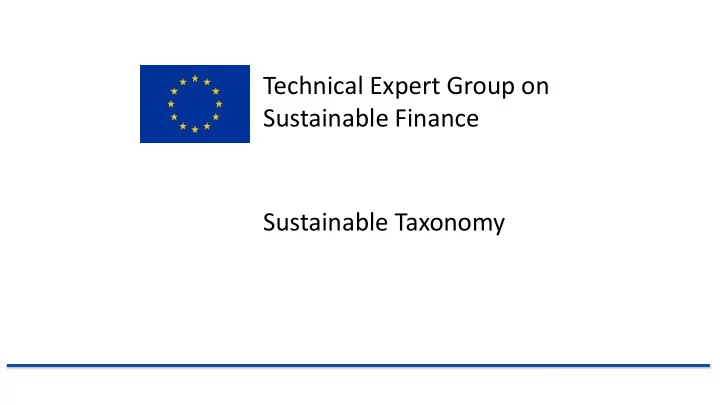

Technical Expert Group on Sustainable Finance Sustainable Taxonomy
Urgency of environmental challenges Source:Trajectories of the Earth System in the Anthropocene, Source:Planetary boundaries, Stockholm Resilience Centre Steffen et al. http://www.pnas.org/content/115/33/8252
Six environmental objectives Climate change mitigation Climate change adaptation sustainable and protection of transition to a circular economy water and musearine resources; protection and restoration of pollution prevention and control; biodiversity and ecosystems.
Six environmental objectives – the goals Climate change mitigation Climate change adaptation • Net zero by 2050 • Build capacity • 50% to 55% reductions • Increase resilience by 2030
Climate change mitigation - opportunities for finance 2030 targets in line with UN 2030 Agenda, SDGs, Paris Agreement Minimum 50%-55% cut At least 32% share of At least 32.5% energy in GHG emissions renewables in final savings compared with compared to 1990 energy consumption business-as-usual Yearly investment gap Public Private € 175 to 290 billion. money money 2050 target of net zero emissions
Climate ‘Transition’ must have a destination Non-CO2 other Different zero GHG pathways Non-CO2 Agriculture lead to different levels of remaining emissions and Residential absorption of GHG emissions Tertiary Transport Industry Power Carbon Removal Technologies MtCO2eq MtCO2eq LULUCF Net emissions Source: 2050 long term strategy, https://ec.europa.eu/clima/policies/strategies/2050_en
Climate ‘Transition’ – TEG response • Clarity on the environmental goal • Transition activities and criteria that reduce over time • Capex and op-ex count • Improvement measures count • But not every activity is sustainable (or ‘green’) • Avoid lock-in
A Taxonomy framework fit for purpose
TEG Reports: March 2020 Summary Report ▪ Key concepts & important design decisions ▪ Detailed guidance for investors and companies ▪ Commentary on future development Technical Annex ▪ Full methodologies ▪ Detailed criteria with detailed rationale ▪ Mitigation + Adaptation + DNSH Taxonomy spreadsheet ▪ All criteria in summary form ▪ Tables for economic classification systems
What has TEG changed since June 2019 1. Received your feedback Updated 70 mitigation activities • 2. Created 68 adaptation activities Including DNSH to mitigation criteria • 3. Guidance for companies and financial participants 4. Learning on international harmonisation 5. Learning on future taxonomy
What is in the Taxonomy now? Mitigation Adaptation 8 8 9 9 25 25 12 12 10 10 2 - 4 2 - 1 Insurance services - 1 Engineering services
Expanded guidance for users How to apply the Taxonomy to an equity portfolio Company A Company B Company C Company Company Company activities activities activities % Taxonomy- 12% 8% 15% aligned 30% weight 50% weight 20% weight Portfolio Taxonomy- My equity fund is 10.6% taxonomy-aligned alignment
Who must do what by when? Disclosures for activities Disclosures for activities Adoption DA: Specifying related to cc mitigation and related to all environmental disclosure obligations for Companies adaptation (covering the objectives (covering the financial and non-financial under Art. financial year 2021, publication in financial year 2022, publication in companies 19a or 29a the course of 2022) the course of 2023) of the NFRD 31/12/2020 01/06/2021 31/12/2021 31/12/2022 Adoption DA: Technical Adoption DA: Technical screening criteria for cc screening criteria for the other mitigation and cc adaptation environmental objectives Disclosures in relation to cc Disclosures in relation to all mitigation and adaptation in environmental objectives in periodic reports, pre-contractual periodic reports, pre-contractual disclosures and on websites disclosures and on websites Financial market Participants
Timeline for future technical work Technical Submit final TEG mandate Expert recommendations ends Group March 2020 Sept 2020 May 2020 End of 2020 Throughout 2021 Platform on Criteria for environmental o Nominations for Platform Platform Sustainable objectives 3 – 6 developed opens operational Finance
Transition from environmentally harmful performance Both SC and DNSH thresholds reduce towards zero by 2050 SC threshold Zero emissions DNSH threshold Very low CO2e intensity Very high Substantially Not sustainable but not Significantly contributing significantly harmful harmful and can be (for now) or so-called “brown” called sustainable
A basis for international harmonisation
Basis for international harmonisation 1. Clear environmental objectives • e.g. Target year and emissions budget or target 2. A list of economic activities 3. Performance metrics 4. Performance thresholds
Panel discussion – What’s new? Nancy Saich, Chief Climate Change Expert, European Investment Bank Sandrine Dixson-Decleve, Advisory Board, Climate-Kic and Co- president, The Club of Rome Sean Kidney, CEO and Co-founder, Climate Bonds Initiative
Adaptation activities
Responding to technical feedback – distribution 577 223 145 2975
Responding to technical feedback
Proposed criteria Transport Agriculture Zero tailpipe & very low emissions: Maintaining carbon; electric; hydrogen Improving carbon; Best practice farming Water & waste management Energy efficiency; Manufacturing Adaptation Low carbon components; Aluminium; Steel; Concrete; Plastics
Proposed criteria Electricity: 100gms Coe/KWh Solar, wind, geothermal, hydro Gas only if with CCS enabled Buildings Storage, transmission Top 15%, or 30% improvements Supply chain / SMEs Forestry Maintaining carbon Improving carbon
Recommend
More recommend